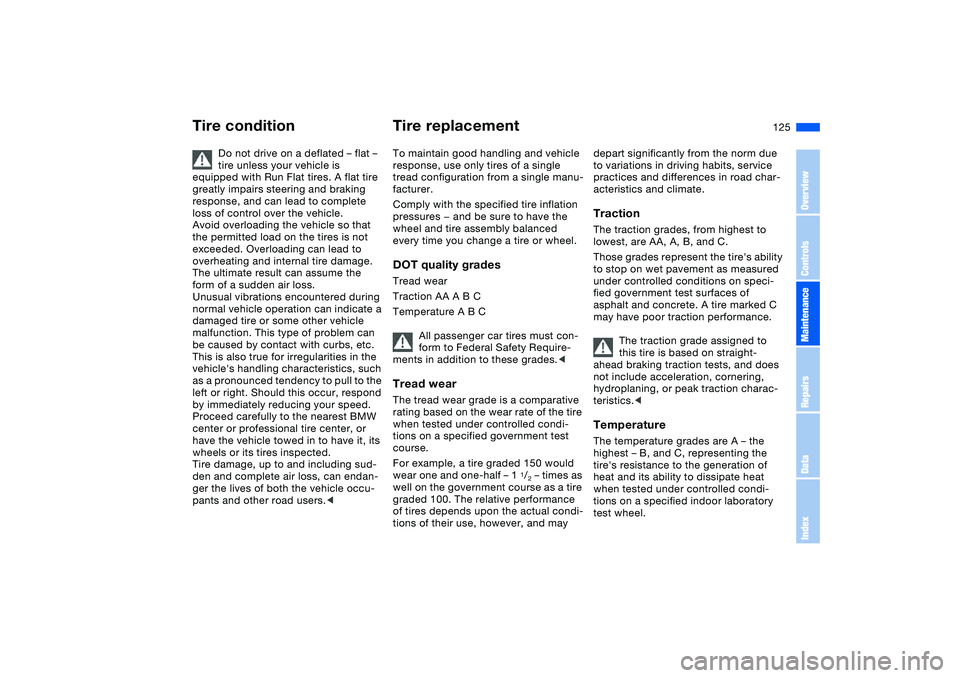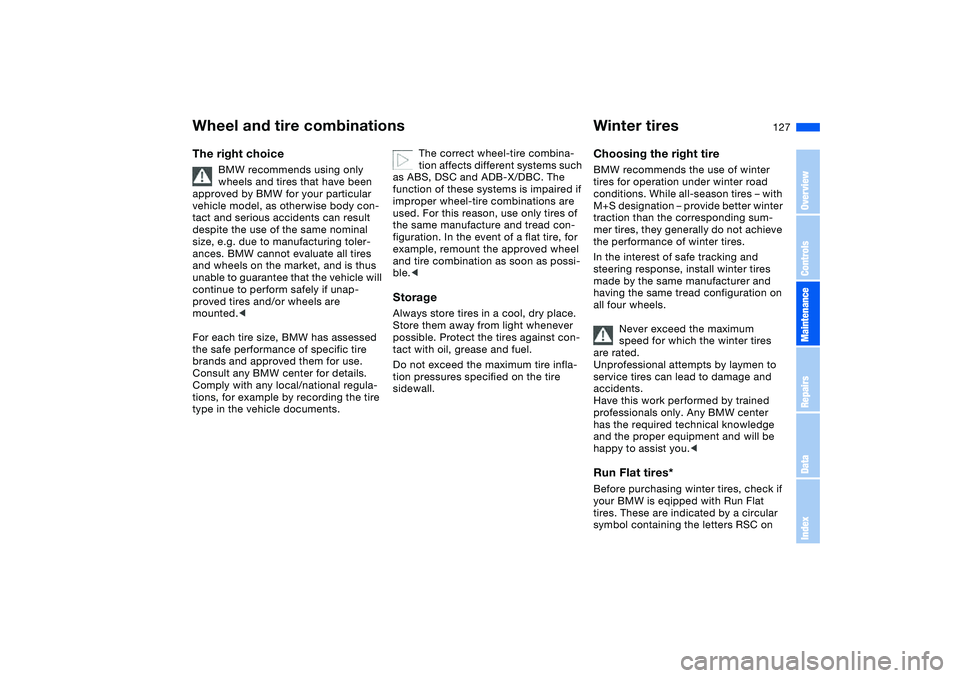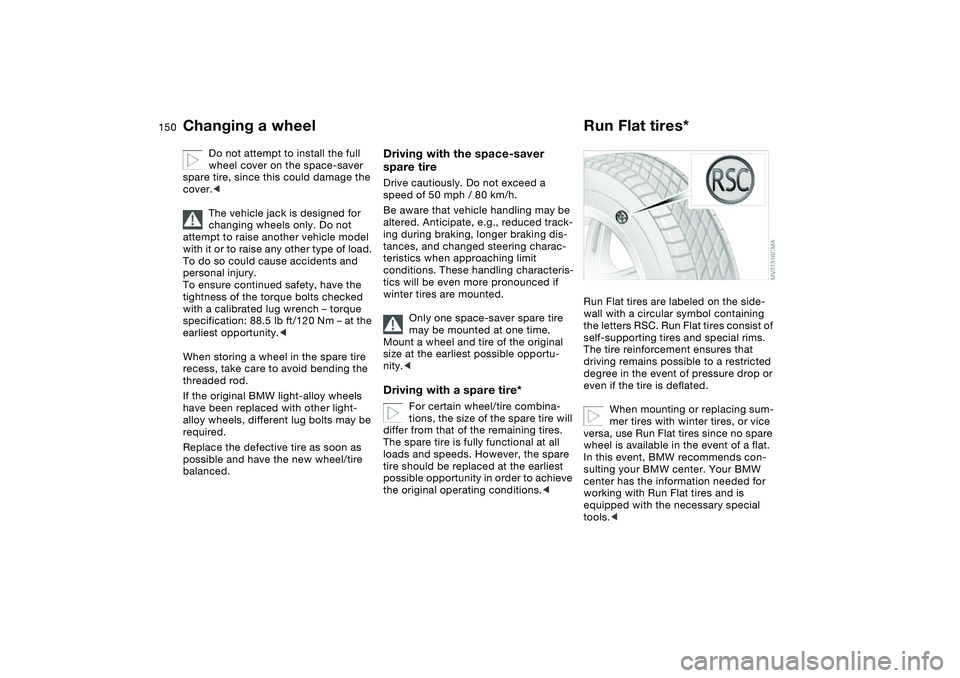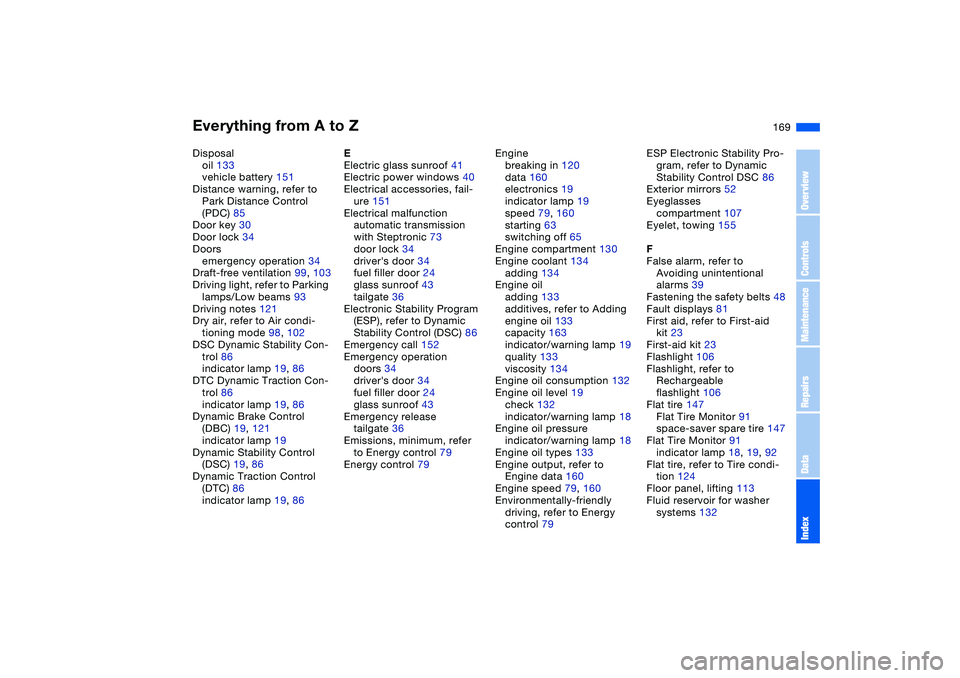2005 BMW 325I SPORT WAGON tire type
[x] Cancel search: tire typePage 125 of 178

125
Do not drive on a deflated – flat –
tire unless your vehicle is
equipped with Run Flat tires. A flat tire
greatly impairs steering and braking
response, and can lead to complete
loss of control over the vehicle.
Avoid overloading the vehicle so that
the permitted load on the tires is not
exceeded. Overloading can lead to
overheating and internal tire damage.
The ultimate result can assume the
form of a sudden air loss.
Unusual vibrations encountered during
normal vehicle operation can indicate a
damaged tire or some other vehicle
malfunction. This type of problem can
be caused by contact with curbs, etc.
This is also true for irregularities in the
vehicle's handling characteristics, such
as a pronounced tendency to pull to the
left or right. Should this occur, respond
by immediately reducing your speed.
Proceed carefully to the nearest BMW
center or professional tire center, or
have the vehicle towed in to have it, its
wheels or its tires inspected.
Tire damage, up to and including sud-
den and complete air loss, can endan-
ger the lives of both the vehicle occu-
pants and other road users.<
Tire replacementTo maintain good handling and vehicle
response, use only tires of a single
tread configuration from a single manu-
facturer.
Comply with the specified tire inflation
pressures — and be sure to have the
wheel and tire assembly balanced
every time you change a tire or wheel.DOT quality gradesTread wear
Traction AA A B C
Temperature A B C
All passenger car tires must con-
form to Federal Safety Require-
ments in addition to these grades.
when tested under controlled condi-
tions on a specified government test
course.
For example, a tire graded 150 would
wear one and one-half – 1
1/2 – times as
well on the government course as a tire
graded 100. The relative performance
of tires depends upon the actual condi-
tions of their use, however, and may
depart significantly from the norm due
to variations in driving habits, service
practices and differences in road char-
acteristics and climate.TractionThe traction grades, from highest to
lowest, are AA, A, B, and C.
Those grades represent the tire's ability
to stop on wet pavement as measured
under controlled conditions on speci-
fied government test surfaces of
asphalt and concrete. A tire marked C
may have poor traction performance.
The traction grade assigned to
this tire is based on straight-
ahead braking traction tests, and does
not include acceleration, cornering,
hydroplaning, or peak traction charac-
teristics.
tire's resistance to the generation of
heat and its ability to dissipate heat
when tested under controlled condi-
tions on a specified indoor laboratory
test wheel.
Tire condition
OverviewControlsMaintenanceRepairsDataIndex
Page 127 of 178

127
Wheel and tire combinationsThe right choice
BMW recommends using only
wheels and tires that have been
approved by BMW for your particular
vehicle model, as otherwise body con-
tact and serious accidents can result
despite the use of the same nominal
size, e.g. due to manufacturing toler-
ances. BMW cannot evaluate all tires
and wheels on the market, and is thus
unable to guarantee that the vehicle will
continue to perform safely if unap-
proved tires and/or wheels are
mounted.<
For each tire size, BMW has assessed
the safe performance of specific tire
brands and approved them for use.
Consult any BMW center for details.
Comply with any local/national regula-
tions, for example by recording the tire
type in the vehicle documents.
The correct wheel-tire combina-
tion affects different systems such
as ABS, DSC and ADB-X/DBC. The
function of these systems is impaired if
improper wheel-tire combinations are
used. For this reason, use only tires of
the same manufacture and tread con-
figuration. In the event of a flat tire, for
example, remount the approved wheel
and tire combination as soon as possi-
ble.<
StorageAlways store tires in a cool, dry place.
Store them away from light whenever
possible. Protect the tires against con-
tact with oil, grease and fuel.
Do not exceed the maximum tire infla-
tion pressures specified on the tire
sidewall.
Winter tiresChoosing the right tireBMW recommends the use of winter
tires for operation under winter road
conditions. While all-season tires – with
M+S designation – provide better winter
traction than the corresponding sum-
mer tires, they generally do not achieve
the performance of winter tires.
In the interest of safe tracking and
steering response, install winter tires
made by the same manufacturer and
having the same tread configuration on
all four wheels.
Never exceed the maximum
speed for which the winter tires
are rated.
Unprofessional attempts by laymen to
service tires can lead to damage and
accidents.
Have this work performed by trained
professionals only. Any BMW center
has the required technical knowledge
and the proper equipment and will be
happy to assist you.
tires. These are indicated by a circular
symbol containing the letters RSC on
OverviewControlsMaintenanceRepairsDataIndex
Page 150 of 178

150
Do not attempt to install the full
wheel cover on the space-saver
spare tire, since this could damage the
cover.<
The vehicle jack is designed for
changing wheels only. Do not
attempt to raise another vehicle model
with it or to raise any other type of load.
To do so could cause accidents and
personal injury.
To ensure continued safety, have the
tightness of the torque bolts checked
with a calibrated lug wrench – torque
specification: 88.5 lb ft/120 Nm – at the
earliest opportunity.<
When storing a wheel in the spare tire
recess, take care to avoid bending the
threaded rod.
If the original BMW light-alloy wheels
have been replaced with other light-
alloy wheels, different lug bolts may be
required.
Replace the defective tire as soon as
possible and have the new wheel/tire
balanced.
Driving with the space-saver
spare tireDrive cautiously. Do not exceed a
speed of 50 mph / 80 km/h.
Be aware that vehicle handling may be
altered. Anticipate, e.g., reduced track-
ing during braking, longer braking dis-
tances, and changed steering charac-
teristics when approaching limit
conditions. These handling characteris-
tics will be even more pronounced if
winter tires are mounted.
Only one space-saver spare tire
may be mounted at one time.
Mount a wheel and tire of the original
size at the earliest possible opportu-
nity.
tions, the size of the spare tire will
differ from that of the remaining tires.
The spare tire is fully functional at all
loads and speeds. However, the spare
tire should be replaced at the earliest
possible opportunity in order to achieve
the original operating conditions.<
Run Flat tires*Run Flat tires are labeled on the side-
wall with a circular symbol containing
the letters RSC. Run Flat tires consist of
self-supporting tires and special rims.
The tire reinforcement ensures that
driving remains possible to a restricted
degree in the event of pressure drop or
even if the tire is deflated.
When mounting or replacing sum-
mer tires with winter tires, or vice
versa, use Run Flat tires since no spare
wheel is available in the event of a flat.
In this event, BMW recommends con-
sulting your BMW center. Your BMW
center has the information needed for
working with Run Flat tires and is
equipped with the necessary special
tools.<
Changing a wheel
Page 169 of 178

Everything from A to Z
169
Disposal
oil 133
vehicle battery 151
Distance warning, refer to
Park Distance Control
(PDC) 85
Door key 30
Door lock 34
Doors
emergency operation 34
Draft-free ventilation 99, 103
Driving light, refer to Parking
lamps/Low beams 93
Driving notes 121
Dry air, refer to Air condi-
tioning mode 98, 102
DSC Dynamic Stability Con-
trol 86
indicator lamp 19, 86
DTC Dynamic Traction Con-
trol 86
indicator lamp 19, 86
Dynamic Brake Control
(DBC) 19, 121
indicator lamp 19
Dynamic Stability Control
(DSC) 19, 86
Dynamic Traction Control
(DTC) 86
indicator lamp 19, 86E
Electric glass sunroof 41
Electric power windows 40
Electrical accessories, fail-
ure 151
Electrical malfunction
automatic transmission
with Steptronic 73
door lock 34
driver's door 34
fuel filler door 24
glass sunroof 43
tailgate 36
Electronic Stability Program
(ESP), refer to Dynamic
Stability Control (DSC) 86
Emergency call 152
Emergency operation
doors 34
driver's door 34
fuel filler door 24
glass sunroof 43
Emergency release
tailgate 36
Emissions, minimum, refer
to Energy control 79
Energy control 79Engine
breaking in 120
data 160
electronics 19
indicator lamp 19
speed 79, 160
starting 63
switching off 65
Engine compartment 130
Engine coolant 134
adding 134
Engine oil
adding 133
additives, refer to Adding
engine oil 133
capacity 163
indicator/warning lamp 19
quality 133
viscosity 134
Engine oil consumption 132
Engine oil level 19
check 132
indicator/warning lamp 18
Engine oil pressure
indicator/warning lamp 18
Engine oil types 133
Engine output, refer to
Engine data 160
Engine speed 79, 160
Environmentally-friendly
driving, refer to Energy
control 79ESP Electronic Stability Pro-
gram, refer to Dynamic
Stability Control DSC 86
Exterior mirrors 52
Eyeglasses
compartment 107
Eyelet, towing 155
F
False alarm, refer to
Avoiding unintentional
alarms 39
Fastening the safety belts 48
Fault displays 81
First aid, refer to First-aid
kit 23
First-aid kit 23
Flashlight 106
Flashlight, refer to
Rechargeable
flashlight 106
Flat tire 147
Flat Tire Monitor 91
space-saver spare tire 147
Flat Tire Monitor 91
indicator lamp 18, 19, 92
Flat tire, refer to Tire condi-
tion 124
Floor panel, lifting 113
Fluid reservoir for washer
systems 132
OverviewControlsMaintenanceRepairsDataIndex